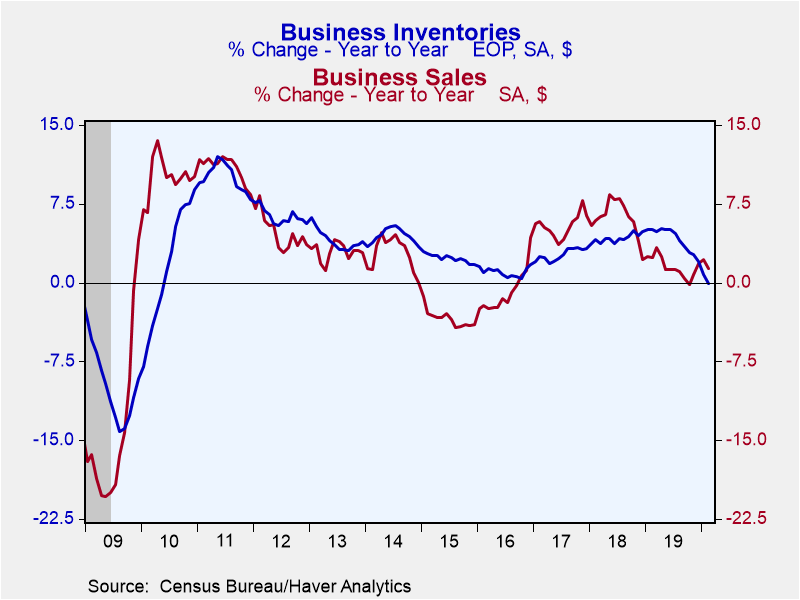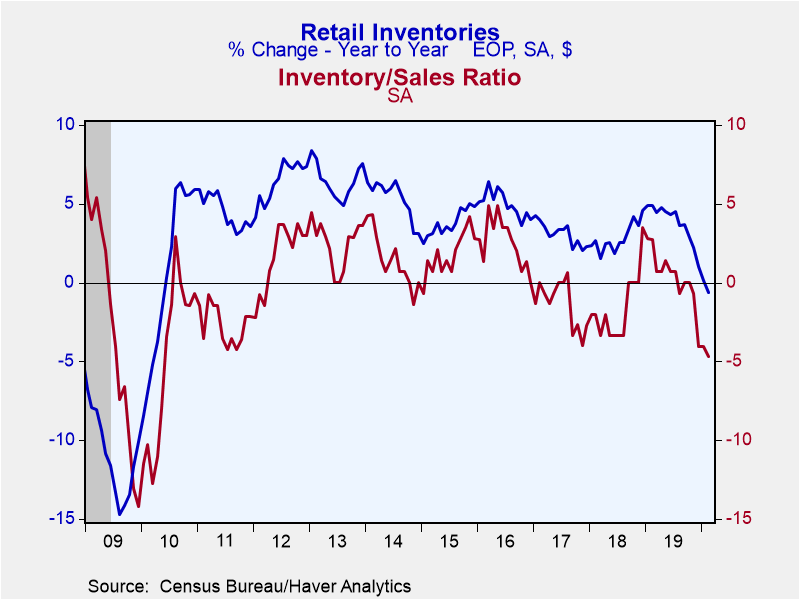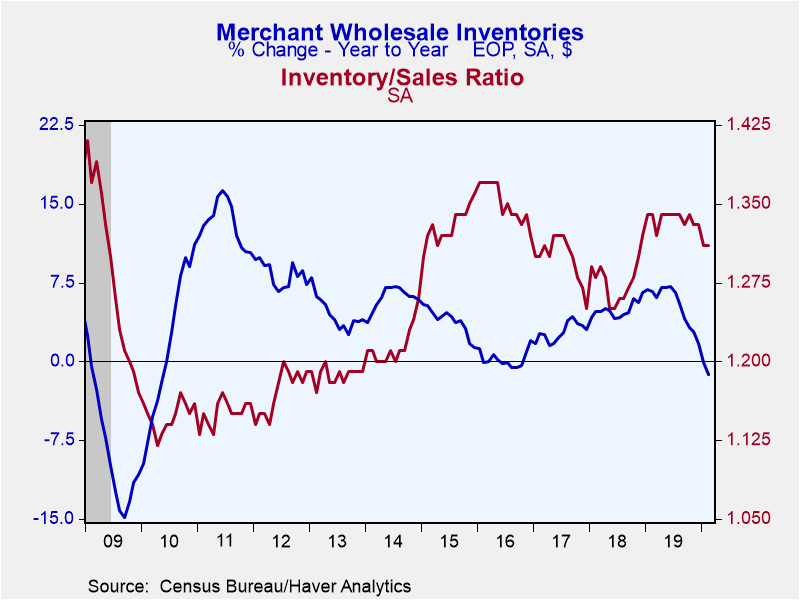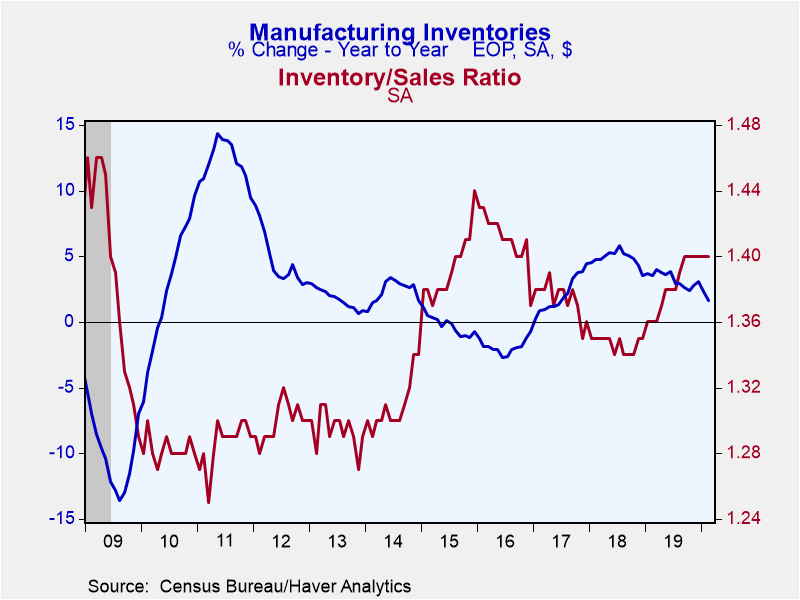 Global| Apr 15 2020
Global| Apr 15 2020U.S. Business Inventories and Sales Decline in February
by:Sandy Batten
|in:Economy in Brief
Summary
Total business inventories fell 0.4% m/m (-0.1% y/y) in February, in line with expectations, following a downwardly revised 0.3% m/m decline in January. The anticipated figure is from the Informa Global Markets survey. Business sales [...]
Total business inventories fell 0.4% m/m (-0.1% y/y) in February, in line with expectations, following a downwardly revised 0.3% m/m decline in January. The anticipated figure is from the Informa Global Markets survey. Business sales decreased 0.5% m/m (+1.4% y/y), offsetting a slightly downwardly revised 0.5% m/m gain in January. The similar monthly falls in sales and in inventories in February left the inventory-to-sales ratio unchanged at 1.37, its lowest reading since November 2018.
Retail inventories declined 0.3%m/m (-0.6% y/y) for their fourth consecutive monthly decline. Excluding a 0.8% m/m drop in motor vehicle inventories, the remainder of retail inventories was unchanged in February. Wholesale inventories slumped 0.7% m/m (-1.3% y/y) in February while manufacturing inventories decreased 0.4% m/m (+1.6% y/y).
Sales at retail stores (excluding sales of food services) fell 0.5% m/m in February but this news was eclipsed by the stunning 6.2% m/m collapse reported for March (in a separate report this morning) as the shutdowns generated by the spread of the coronavirus seriously dented consumer spending. Wholesale sector sales slumped 0.8% m/m (+1.1% y/y) in February after a 1.3% m/m jump in January. Shipments from the factory sector declined 0.2% (-1.1% y/y) in February on top of a 0.6% m/m decline in January.
Inventory-to-sales ratios across all sectors were unchanged in February as both sales and inventories declined by roughly equal amounts. The overall I/S ratio remained at 1.37. The retail sector I/S ratio remained at 1.42, the lowest level since November 2014. For merchant wholesalers, the I/S ratio stayed at 1.31, the lowest since November 2018. The factory sector I/S ratio was steady at 1.40, the highest level since November 2016.
The manufacturing and trade data are in Haver's USECON database.
| Manufacturing & Trade | Feb | Jan | Dec | Feb Y/Y | 2019 | 2018 | 2017 |
|---|---|---|---|---|---|---|---|
| Business Inventories (% chg) | -0.4 | -0.3 | 0.1 | -0.1 | 2.1 | 5.1 | 3.4 |
| Retail | -0.3 | -0.1 | -0.1 | -0.6 | 1.0 | 4.5 | 2.3 |
| Retail excl. Motor Vehicles | 0.0 | 0.3 | 0.0 | 1.1 | 1.9 | 1.8 | 2.0 |
| Merchant Wholesalers | -0.7 | -0.6 | 0.0 | -1.3 | 2.0 | 7.3 | 3.3 |
| Manufacturing | -0.4 | -0.3 | 0.4 | 1.6 | 3.1 | 3.5 | 4.5 |
| Business Sales (% chg) | |||||||
| Total | -0.5 | 0.5 | 0.0 | 1.4 | 1.5 | 6.1 | 5.4 |
| Retail | -0.5 | 0.7 | -0.1 | 4.5 | 3.4 | 4.6 | 4.5 |
| Retail excl. Motor Vehicle | -0.5 | 0.7 | 0.4 | 4.1 | 3.2 | 5.3 | 4.8 |
| Merchant Wholesalers | -0.8 | 1.3 | -0.4 | 1.1 | 0.7 | 6.7 | 6.7 |
| Manufacturing | -0.2 | -0.6 | 0.5 | -1.1 | 0.7 | 6.9 | 5.0 |
| I/S Ratio | |||||||
| Total | 1.37 | 1.37 | 1.39 | 1.39 | 1.40 | 1.36 | 1.38 |
| Retail | 1.42 | 1.42 | 1.43 | 1.49 | 1.45 | 1.45 | 1.47 |
| Retail excl. Motor Vehicles | 1.18 | 1.18 | 1.18 | 1.22 | 1.19 | 1.20 | 1.24 |
| Merchant Wholesalers | 1.31 | 1.31 | 1.33 | 1.34 | 1.35 | 1.29 | 1.30 |
| Manufacturing | 1.40 | 1.40 | 1.40 | 1.36 | 1.38 | 1.35 | 1.37 |
Sandy Batten
AuthorMore in Author Profile »Sandy Batten has more than 30 years of experience analyzing industrial economies and financial markets and a wide range of experience across the financial services sector, government, and academia. Before joining Haver Analytics, Sandy was a Vice President and Senior Economist at Citibank; Senior Credit Market Analyst at CDC Investment Management, Managing Director at Bear Stearns, and Executive Director at JPMorgan. In 2008, Sandy was named the most accurate US forecaster by the National Association for Business Economics. He is a member of the New York Forecasters Club, NABE, and the American Economic Association. Prior to his time in the financial services sector, Sandy was a Research Officer at the Federal Reserve Bank of St. Louis, Senior Staff Economist on the President’s Council of Economic Advisors, Deputy Assistant Secretary for Economic Policy at the US Treasury, and Economist at the International Monetary Fund. Sandy has taught economics at St. Louis University, Denison University, and Muskingun College. He has published numerous peer-reviewed articles in a wide range of academic publications. He has a B.A. in economics from the University of Richmond and a M.A. and Ph.D. in economics from The Ohio State University.










